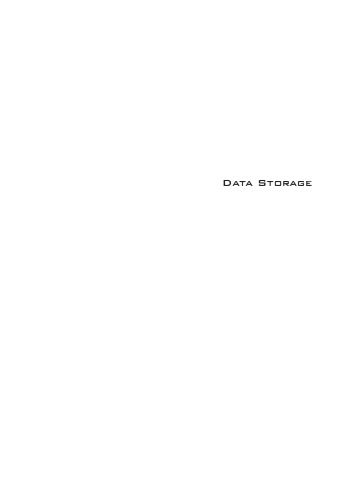Data Storage 1st Edition by Caio Almeida Cunha ISBN 1536128279 9781536128277 by Florin Balasa 9789533070636, 9533070633 instant download after payment.
Data Storage 1st Edition by Caio Almeida Cunha - Ebook PDF Instant Download/Delivery: 1536128279, 9781536128277
Full download Data Storage 1st Edition after payment

Product details:
ISBN 10: 1536128279
ISBN 13: 9781536128277
Author: Caio Almeida Cunha
Data Storage 1st Table of contents:
Part I: Fundamental Principles and Technologies
Chapter 1: Basics of Digital Data Representation
- A. Binary Representation: Bits, bytes, words.
- B. Data Encoding and Decoding.
- C. File Systems: Logical Organization of Data.
Chapter 2: Magnetic Storage Technologies
- A. Hard Disk Drives (HDDs):
- Components (platters, heads, motor, controller).
- Recording principles (magnetic domains).
- Performance metrics (RPM, seek time, latency).
- Form factors and interfaces (SATA, SAS, SCSI).
- B. Magnetic Tape:
- Principles of operation.
- Applications in backup and archival.
- Linear Tape-Open (LTO) technology.
Chapter 3: Solid-State Storage Technologies
- A. Flash Memory:
- NAND vs. NOR flash.
- Cell types (SLC, MLC, TLC, QLC) and their characteristics.
- Wear leveling and garbage collection.
- B. Solid-State Drives (SSDs):
- Architectures (SATA, NVMe, PCIe).
- Performance advantages and endurance considerations.
- C. Emerging Non-Volatile Memory (NVM) Technologies:
- 3D XPoint (Intel Optane), Resistive RAM (RRAM), Phase-Change Memory (PCM).
Chapter 4: Optical Storage Technologies
- A. CDs, DVDs, and Blu-ray Discs:
- Principles of laser recording and reading.
- Capacities and formats.
- B. Archival Optical Media:
- M-DISC, specialized archival solutions.
Part II: Storage Architectures and Systems
Chapter 5: Direct-Attached Storage (DAS)
- A. Principles and Use Cases.
- B. Limitations of DAS.
Chapter 6: Network-Attached Storage (NAS)
- A. Concepts of File-Level Storage.
- B. NAS Devices and Appliances.
- C. Protocols: NFS, SMB/CIFS.
- D. Use Cases: Home, Small Business, Collaboration.
Chapter 7: Storage Area Networks (SAN)
- A. Concepts of Block-Level Storage.
- B. Technologies: Fibre Channel (FC), iSCSI.
- C. SAN Components: HBAs, FC switches, SAN arrays.
- D. Use Cases: Databases, Virtualization, High-Performance Computing.
Chapter 8: Storage Virtualization
- A. Concepts and Benefits (abstraction, flexibility, management).
- B. Types of Virtualization: Host-based, Storage-based, Network-based.
- C. Thin Provisioning, Data Deduplication, Compression.
Chapter 9: Redundant Array of Independent Disks (RAID)
- A. RAID Levels (0, 1, 5, 6, 10, etc.):
- Functionality, performance, and fault tolerance.
- B. Hardware vs. Software RAID.
- C. RAID Limitations and Alternatives.
Part III: Data Management, Security, and Cloud Storage
Chapter 10: Data Backup and Recovery
- A. Backup Strategies: Full, Incremental, Differential.
- B. Recovery Point Objective (RPO) and Recovery Time Objective (RTO).
- C. Backup Technologies and Software.
- D. Disaster Recovery and Business Continuity Planning.
Chapter 11: Data Archiving and Long-Term Retention
- A. Differentiating Backup from Archiving.
- B. Compliance and Regulatory Requirements.
- C. Archival Media and Technologies.
Chapter 12: Data Security in Storage
- A. Data Encryption (at rest and in transit).
- B. Access Control and Authentication.
- C. Data Integrity and Tamper Detection.
- D. Compliance and Privacy Regulations (GDPR, HIPAA).
Chapter 13: Cloud Storage
- A. Models: IaaS (Object, Block, File), PaaS, SaaS.
- B. Major Cloud Providers (AWS S3, Azure Blob, Google Cloud Storage).
- C. Hybrid Cloud Storage.
- D. Benefits and Challenges of Cloud Storage:
- Scalability, cost, performance, security, vendor lock-in.
Chapter 14: Emerging Trends and Future of Data Storage
- A. Storage Class Memory (SCM).
- B. Persistent Memory.
- C. DNA Data Storage.
- D. Distributed Ledger Technologies (Blockchain) for data integrity.
- E. Edge Storage.
- F. Storage in Quantum Computing.
People also search for Data Storage 1st:
data storage
computer data storage
dna data storage
cloud data storage
long term data storage
Tags: Caio Almeida Cunha, Data, Storage



